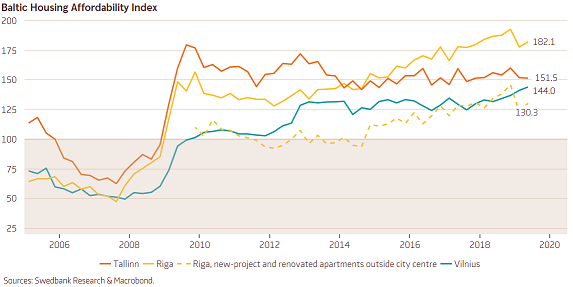"In Riga, the HAI decreased by 4.7 points to 182.1 as apartment price growth outperformed net wage growth, but interest rates slightly increased. For new-projects and renovated apartments, the HAI decreased by 4.1 to 130.3," said Swedbank.
The housing affordability index (HAI) is calculated for a family whose income is equal to 1.5 of average net wages with an average-sized apartment of 55 square meters. The HAI is 100 when households use 30% of their net wages for mortgage costs. When the HAI is at least 100, households can afford their housing, according to the established norm. The higher the index, the greater the affordability.
The HAI value of 151.5 in Tallinn means that the net wages of a household in this city are 51.5% higher than required to afford an apartment, according to the methodology (mortgage costs account for 30% of the net wages of a household that earns 1.5 of the average net wage). In Riga, household net wages are 82.1% higher (30.3% for new-project and renovated apartments) — and, in Vilnius, 44% higher — than required to fulfil the norm.
"In the second quarter of 2019, the HAI in Riga decreased. The average price of apartments experienced faster growth than net wages; therefore, apartments became less affordable. The total transaction count in Riga decreased on annual basis; this was mainly connected to declining transactions involving Soviet-era apartments. But the transaction count with new apartments increased in the first half of this year by more than 30%," said Swedbank.
"The reason for this rapid growth of transactions involving new apartments might be due to the procedure for purchasing and registering property. For example, part of these purchases could have occurred a year ago, while the apartments were being built, but, the purchasing was documented and registered only when the apartments were finished. However, the share of transactions in Riga involving new apartments is still rising. Singles and young families with rising income choose newly built apartments as more pleasant places to live. Moreover, the growing recognition of the support program for young families and professionals may be influencing the real estate market, because it is granting mortgages with lower initial instalments, which might encourage these groups to purchase apartments.
"The rising demand for new projects in the Riga suburbs is being met with supply from the construction side. Currently, around 2,000 new apartments are in the construction stage; these will provide new housing opportunities for at least the next five years. As a result, growth of prices may slow slightly.
"However, transactions involving Soviet-era apartments still dominate the market, accounting for around two-thirds of total deals. These Soviet-era apartments are still more affordable due to lower prices (average price of Soviet-era apartment is 55% lower than the average price of newly-built apartment in sleeping district). Moreover, the price growth of Soviet-era apartments has slowed or even in some cases stopped. On the other hand, the condition of these houses is poor. This is one more factor that allows new projects to grow their share of the market. In Riga, the average transaction price has remained lower than in the other Baltic capitals. This creates the potential for long-term growth of the real estate market in Riga, as there is rising demand," Swedbank said.






























